Dag,
Iris (Mnt Pleasant, 28531 miles)

 The flooding makes this park so unique. The floodwater deposits rich soil whose nutrients support the complex plant communities and the unusual giant trees the park is famous for. Depending on the time a region is flooded (due to elevation difference), the soil changes drastically and with it the forest above it. Yes, the flood plain is a forest and not the wide open grass fields I am used to.
The flooding makes this park so unique. The floodwater deposits rich soil whose nutrients support the complex plant communities and the unusual giant trees the park is famous for. Depending on the time a region is flooded (due to elevation difference), the soil changes drastically and with it the forest above it. Yes, the flood plain is a forest and not the wide open grass fields I am used to.  Its interesting navigating but it’s a wonderful place to be.
Its interesting navigating but it’s a wonderful place to be. The whole forest is flooded and in places I measure 1.5 meter deep.
The whole forest is flooded and in places I measure 1.5 meter deep. The water is flowing pretty steadily in the direction of the ocean and it is not always easy to keep the kayak on the trail.
The water is flowing pretty steadily in the direction of the ocean and it is not always easy to keep the kayak on the trail.  With my compass I have to bushwhack away from the trail until I finally find the creek.
With my compass I have to bushwhack away from the trail until I finally find the creek.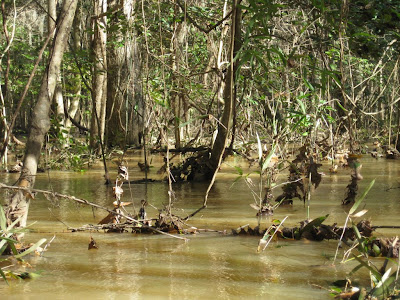 Which is easy to paddle and brings me right back to the Oto.
Which is easy to paddle and brings me right back to the Oto.  I am scratched by branches, my kayak took a good beating, but it was all well worth it.
I am scratched by branches, my kayak took a good beating, but it was all well worth it.  Fun
Fun Having worked in a startup company in Silicon Valley it’s almost beyond believe to understand how much success this company has. Its the best know product in the world, making their marketing department probably the most efficient department in the world.
Having worked in a startup company in Silicon Valley it’s almost beyond believe to understand how much success this company has. Its the best know product in the world, making their marketing department probably the most efficient department in the world.  There is lots of talk about the famous (not patented) secret recipe and why all over the world Coca-Cola taste the same and why it is so popular. It all makes sense when you think about how this company is set up. The syrup is made in the USA and shipped to local licensed bottle factories. These factories dilute the syrup 6.5 times, fill the bottles and distribute it, making it available in every corner of the planet.
There is lots of talk about the famous (not patented) secret recipe and why all over the world Coca-Cola taste the same and why it is so popular. It all makes sense when you think about how this company is set up. The syrup is made in the USA and shipped to local licensed bottle factories. These factories dilute the syrup 6.5 times, fill the bottles and distribute it, making it available in every corner of the planet.  I always understood that the first recipe of Coca-Cola had cocaine as an ingredient and that’s why it became such a success. In a coca leave museum in Bolivia I also learned that up to today, the Coca-Cola company still imports about 100.000 kg of coca leaves (after the cocaine is extracted) each year, but nothing is mentioned about that in the whole museum. The real trues, why Coca-Cola is such a big success, its because we the people have incorporated it into our daily diet.
I always understood that the first recipe of Coca-Cola had cocaine as an ingredient and that’s why it became such a success. In a coca leave museum in Bolivia I also learned that up to today, the Coca-Cola company still imports about 100.000 kg of coca leaves (after the cocaine is extracted) each year, but nothing is mentioned about that in the whole museum. The real trues, why Coca-Cola is such a big success, its because we the people have incorporated it into our daily diet. 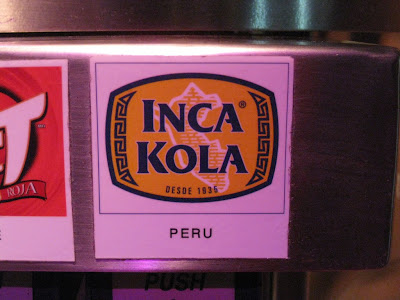 I didn’t know that and besides Inca cola (the only taste I like) I stay with my own caffeine fix, without the sugar: coffee.
I didn’t know that and besides Inca cola (the only taste I like) I stay with my own caffeine fix, without the sugar: coffee. Influenced by the teaching of Gandhi during a trip to India, a non-violence approached for racial justice was taken. King moved back to his birthplace Atlanta to serve as co-pastor besides his father in the Ebenezer Baptist Church, and to become the president of the civil right organization, the Southern Christian Leadership Conference.
Influenced by the teaching of Gandhi during a trip to India, a non-violence approached for racial justice was taken. King moved back to his birthplace Atlanta to serve as co-pastor besides his father in the Ebenezer Baptist Church, and to become the president of the civil right organization, the Southern Christian Leadership Conference.  The years following were filled wit boycotts, speeches and advocating (and practicing) civil disobedience to “immoral laws”. Accumulating for the March on Washington, were 250.000 people gathered to hear Kings electrifying speech: “I have a dream”.
The years following were filled wit boycotts, speeches and advocating (and practicing) civil disobedience to “immoral laws”. Accumulating for the March on Washington, were 250.000 people gathered to hear Kings electrifying speech: “I have a dream”. In 1965 on what was later called; “Bloody Sunday” blacks and sympathized whites, leaded by King were marching 2 by 2 to the state capitol in Montgomery to demonstrate for black voting rights. The peaceful march was beaten down on the Edmund Pettus Bridge and broadcasted all over the world, finally convincing President Johnson to sign the Voting Right Act.
In 1965 on what was later called; “Bloody Sunday” blacks and sympathized whites, leaded by King were marching 2 by 2 to the state capitol in Montgomery to demonstrate for black voting rights. The peaceful march was beaten down on the Edmund Pettus Bridge and broadcasted all over the world, finally convincing President Johnson to sign the Voting Right Act.  Today there is a black president in the USA, but if the entire struggle is over. I doubt it and I will keep my eyes and ears open here down in the South to see how far the world still has to come.
Today there is a black president in the USA, but if the entire struggle is over. I doubt it and I will keep my eyes and ears open here down in the South to see how far the world still has to come.  Now we are down South, me chasing the sun, he moving with his bluegrass band Bearfoot to the center of the country music world. And so it happens, our paths cross again. J invites me to stay over Christmas, promises to play as much mandolin for me as I can stand and submerges me in the world of Bluegrass in Nashville, Tennessee.
Now we are down South, me chasing the sun, he moving with his bluegrass band Bearfoot to the center of the country music world. And so it happens, our paths cross again. J invites me to stay over Christmas, promises to play as much mandolin for me as I can stand and submerges me in the world of Bluegrass in Nashville, Tennessee.  After a romantic dinner for two, J brings me to the Doyle and Debbie show. We hit downtown, and it seems that each bar has at least one life band playing. We are both not impressed with the band we choose and after a beer we head home early.
After a romantic dinner for two, J brings me to the Doyle and Debbie show. We hit downtown, and it seems that each bar has at least one life band playing. We are both not impressed with the band we choose and after a beer we head home early.  For 3 days J and me are hardly separated, more dinners, more coffee, more mandolin, more songs, more talking, more pictures, its just perfect.
For 3 days J and me are hardly separated, more dinners, more coffee, more mandolin, more songs, more talking, more pictures, its just perfect. 
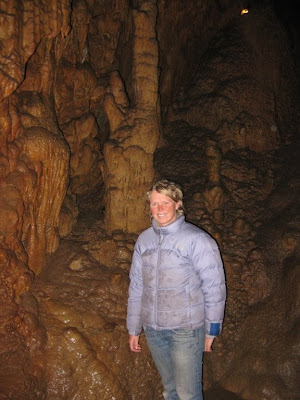
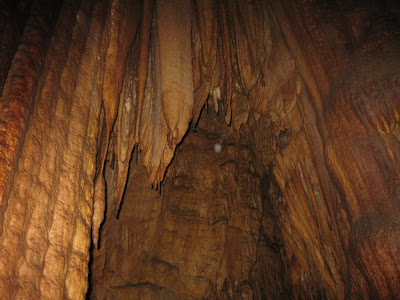
 That night I have to share the shelter with some spring breakers on their first back country trip, and they even need me to finally get the fire going. They are fun company though and we talk until late in the night. The next morning we wake up with snow and its cold.
That night I have to share the shelter with some spring breakers on their first back country trip, and they even need me to finally get the fire going. They are fun company though and we talk until late in the night. The next morning we wake up with snow and its cold.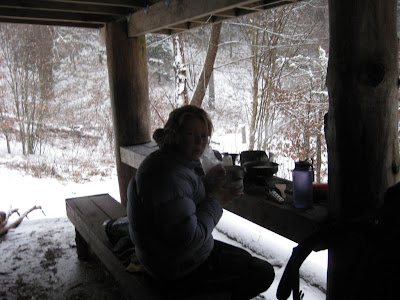 As its only 1 night I took barely any food and when I make an extra strong coffee and bake myself some pancakes not much is left. I am just a little bit worried about the snow, but the day will bring a trail on top of a ridge and with only 11 miles to go, I wave it away.
As its only 1 night I took barely any food and when I make an extra strong coffee and bake myself some pancakes not much is left. I am just a little bit worried about the snow, but the day will bring a trail on top of a ridge and with only 11 miles to go, I wave it away.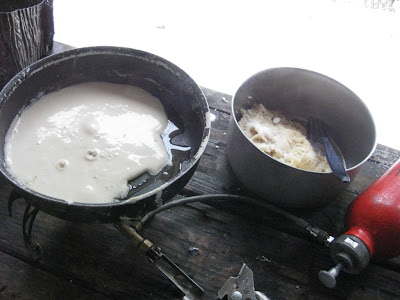 The trail is beautiful, the snow is still falling, but every time it clears up the views are amazing. The going is not too bad, and with my ‘happy to have now’ trekking poles, I make good time.
The trail is beautiful, the snow is still falling, but every time it clears up the views are amazing. The going is not too bad, and with my ‘happy to have now’ trekking poles, I make good time.  Not aware of the major snow storm in years I am in, I keep going. The whole day the snow keeps falling and in the afternoon the temperatures drop. I am getting cold, the going goes slower and slower and many times I fall, not aware of the ice layers underneath the snow.
Not aware of the major snow storm in years I am in, I keep going. The whole day the snow keeps falling and in the afternoon the temperatures drop. I am getting cold, the going goes slower and slower and many times I fall, not aware of the ice layers underneath the snow.  When I make it to the road, I find my bike covered in snow. And jeh right, there is not a single car driving. This road is closed for sure. The snow is now 0.4 meter deep and I start worrying if I will be even able to walk down the road tomorrow.
When I make it to the road, I find my bike covered in snow. And jeh right, there is not a single car driving. This road is closed for sure. The snow is now 0.4 meter deep and I start worrying if I will be even able to walk down the road tomorrow.  Also now I have to keep thinking positive. Worries for tomorrow, lets first find a place to sleep. I drag myself around through the snow for a while and find a shelter. I can hear a pump in the back of the shelter, and it seems indeed a little bit heated inside. Tonight I don’t have to share my shelter, and with 7 private restrooms, it’s not a bad place.
Also now I have to keep thinking positive. Worries for tomorrow, lets first find a place to sleep. I drag myself around through the snow for a while and find a shelter. I can hear a pump in the back of the shelter, and it seems indeed a little bit heated inside. Tonight I don’t have to share my shelter, and with 7 private restrooms, it’s not a bad place.  Grosse, jeh I agree. But sometimes being warm is more important then anything else in the world. With no food left I go to bed on an empty stomach and sleep well after a day out in the snow. I wake up with new energy, there is no breakfast and instead I treat myself with some sugar in my coffee. Well the coffee you have to think with it. That’s gonna be a headache day for sure!
Grosse, jeh I agree. But sometimes being warm is more important then anything else in the world. With no food left I go to bed on an empty stomach and sleep well after a day out in the snow. I wake up with new energy, there is no breakfast and instead I treat myself with some sugar in my coffee. Well the coffee you have to think with it. That’s gonna be a headache day for sure! More snow has been falling and I will be plowing through 0.5 meters today. A long long long day is ahead of me for sure. When I finally dig myself out of the shelter and make it to the road I can’t believe my eyes. The road is plowed, its plowed in the direction I wane go, plowed! So I dig out the bike, clean it from snow as good as I can, and hit the road. Well road, its one big ice sheet, and my front break is frozen over and won’t work. The gear is also not functioning and I am scared and freaking cold. But it goes and slowly I make my way down, stopping every 0.5 km trying to warm up my feet and hands. The road is only down, and I have to hug my rear break to keep my speed in control. Stopping with a big backpack, frozen hands and feet is scary like hell, and I slide all over the road.
More snow has been falling and I will be plowing through 0.5 meters today. A long long long day is ahead of me for sure. When I finally dig myself out of the shelter and make it to the road I can’t believe my eyes. The road is plowed, its plowed in the direction I wane go, plowed! So I dig out the bike, clean it from snow as good as I can, and hit the road. Well road, its one big ice sheet, and my front break is frozen over and won’t work. The gear is also not functioning and I am scared and freaking cold. But it goes and slowly I make my way down, stopping every 0.5 km trying to warm up my feet and hands. The road is only down, and I have to hug my rear break to keep my speed in control. Stopping with a big backpack, frozen hands and feet is scary like hell, and I slide all over the road.  Back at the campground D is now accompanied by his friends J and W, and started to worry a bit about me. Instead of the fire going they have a better idea and take me out for breakfast and finally a coffee. The rest of the day I hug their big fire and we share a hotdog meal in the evening.
Back at the campground D is now accompanied by his friends J and W, and started to worry a bit about me. Instead of the fire going they have a better idea and take me out for breakfast and finally a coffee. The rest of the day I hug their big fire and we share a hotdog meal in the evening.  Jeh, the Smokies, I won’t forget them. And if you wonder how that day on the ridge emotional progressed. Here you go.
Jeh, the Smokies, I won’t forget them. And if you wonder how that day on the ridge emotional progressed. Here you go.
 More colonists arrive but by 1610 only 90 out of the 300 survive the starving winter within the Indians have no extra food left to trade with the British and dogs and human bodies are eaten to be kept alive. Time to had back home.
More colonists arrive but by 1610 only 90 out of the 300 survive the starving winter within the Indians have no extra food left to trade with the British and dogs and human bodies are eaten to be kept alive. Time to had back home. There is however one thing lacking, labour. And in 1619 the first African arrives in Jamestown. Slowly more and more Africans are brought in, but when the Dutch capture the fort of Elmina, Ghana, the slave trade takes off and in 1690 more then 9300 enslaved Africans where among the 53000 white population.
There is however one thing lacking, labour. And in 1619 the first African arrives in Jamestown. Slowly more and more Africans are brought in, but when the Dutch capture the fort of Elmina, Ghana, the slave trade takes off and in 1690 more then 9300 enslaved Africans where among the 53000 white population. In 1781 the American Revolutionary War was 7 years underway. The British had abandoned their effort to reconquer the North and focused their attention to the South. British general Cornwallis let his eye fall on the Chesapeake Bay area, moved in and established a base in Yorktown. This to the displease of American Marquis de Lafayette who had only a small army under his command. But with help of the French fleet under command of Admiral de Grasse who blocked the bay entrance blocking the escape route, and Georges Washington’s large army under command of Comte de Rochambeau, chances changed. And the way it went in 1781, camp was established, trenches were dug, and canons were pointed in the right direction.
In 1781 the American Revolutionary War was 7 years underway. The British had abandoned their effort to reconquer the North and focused their attention to the South. British general Cornwallis let his eye fall on the Chesapeake Bay area, moved in and established a base in Yorktown. This to the displease of American Marquis de Lafayette who had only a small army under his command. But with help of the French fleet under command of Admiral de Grasse who blocked the bay entrance blocking the escape route, and Georges Washington’s large army under command of Comte de Rochambeau, chances changed. And the way it went in 1781, camp was established, trenches were dug, and canons were pointed in the right direction.  Ten days of intense fighting followed until the British surrendered and Cornwallis cried:” Oh God, it is all over!” And so it was, the British went home and the independence of the USA was a fact.
Ten days of intense fighting followed until the British surrendered and Cornwallis cried:” Oh God, it is all over!” And so it was, the British went home and the independence of the USA was a fact.